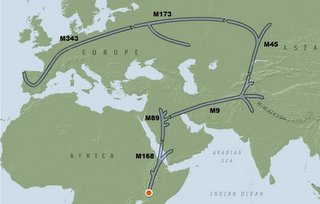 This fall, I contributed my DNA to the Genographic Project, a global research project intent on tracing the human journey through time and around the globe. This is accomplished by following markers, such as those found on the Y-chromosome of men and the mitochondrial DNA of all people. Here's the story of my ancestors' travels, as told in my biochemistry:
This fall, I contributed my DNA to the Genographic Project, a global research project intent on tracing the human journey through time and around the globe. This is accomplished by following markers, such as those found on the Y-chromosome of men and the mitochondrial DNA of all people. Here's the story of my ancestors' travels, as told in my biochemistry:Some 60,000 years ago or so, a man walked out of eastern Africa with his people. Perhaps they had become too numerous for their home environment to support, perhaps they just followed the herds. This man is the common male ancestor of all non-African people today, and through him and his parents, we are all linked back to the beginning of our kind, in Africa, thousands of years before he was born.
45,000 years ago, a decendant of that African man lived in what we now call the Middle East. The grasslands were expanding, from what is now France to Korea. Vast herds of bison, antelope, wooly mammoth and other game led him and his people across the sea of grass, farther and farther away from the Mother Africa.
5,000 years later, a man lived in Central Asia. He bore in his DNA the signs of his fathers before him, but he carried a new marker as well. He passed this on to his sons, and they to theirs, and on and on. Nearly every man in Europe, East Asia, Inda and the Americas bears his mark today. These people dispersed slowly from Central Asia, moving eastward with the herds across the steppes, halting only when they came upon the massive mountain ranges of south-central Asia. The passage here, through the Hindu Kush, Tian Shan and the Himalayas split the lineage, dividing it into many branches.
 The migration of my deep ancestors, as told in my Y-chromosome markers
The migration of my deep ancestors, as told in my Y-chromosome markers
After another 5,000 years or so, a son of the Central Asian lineage was moving north with his people onto the game-rich steppes of what is now Kazakhstan, Uzbekistan and southern Siberia. While the hunting was good, the climate was becoming harsh, and bitterly cold. To survive the Ice Age, this man and his people built hide tents, and sewed weatherproof clothes. Their stone tools became more and more refined. They gathered around the fires by day and night. They thrived in a region where no others are known to have survived.
In time, the sons of the Ice Age hunters turned west, moving into the forests and meadows of Europe. Some of these went down into the caves, painting the beasts they hunted and the visions they had upon the stone walls. Occasionally, they would outline their hands on the rock with red ochre, leaving another kind of marker, to say perhaps, "I was here."
35,000 years ago, a man and his people moved into Europe, carrying exquisite tools and weapons of bone, stone and ivory. He lived in a hut with his family, and wore clothing woven by members of his community. Perhaps he wore a little amulet around his neck, or carved lithe animal forms into his spear-thrower. Perhaps he himself went into the darkness and put his hand-print upon the rough wall. Today, we call this man and his people Cro-Magnon; we shall never know what they called themselves. The long winter of the final Ice Age may have driven them south for a time, as far south as Spain, but no longer than 8000 years ago, they moved into Great Britain for good.
My deep ancestry...Out of Africa, to roam the grasslands of Eurasia for thousands and thousands of years. Then for thousands of years more, to dwell in a corner of Europe. And now I live upon a new sea of grass, stretching from horizon to horizon. Such is the nature of migration: you leave, return, leave again only to come back, though it may be a journey of generations. How many countless people have made this same journey, and have it recorded in their DNA? Dear Reader, some part or all of your deep ancestry follows the same lines; we are related, you and I, all the way back to the beginning.
No comments:
Post a Comment